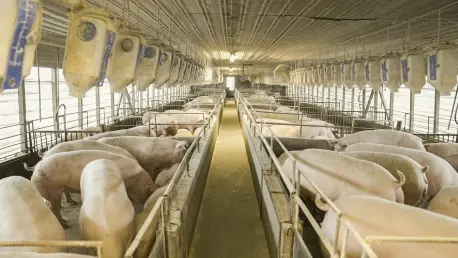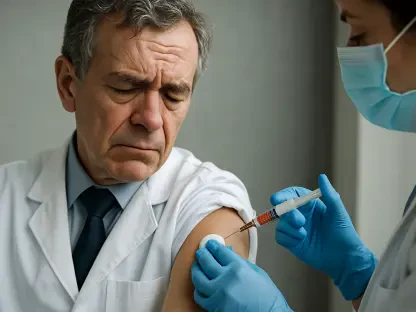In recent years, the global swine industry has faced escalating challenges due to viral pathogens such as African Swine Fever (ASF), Porcine Epidemic Diarrhea (PED), and Porcine Reproductive and Respiratory Syndrome (PRRS). These diseases have forced experts to re-evaluate traditional swine health management practices. One critical aspect gaining attention is feed biosecurity, as research increasingly underscores its pivotal role in preventing disease transmission within swine populations. This evolving understanding has resulted in renewed efforts to fortify the swine industry’s resilience against viruses through strategic feed management.
Understanding Feed as a Vector for Disease Transmission
Recognizing Risks in Feed Ingredients
The realization that feed can serve as a vector for viral transmission marks a significant evolution in swine health management strategies. Traditionally, the focus was on direct contact among animals and environmental exposure. However, mounting evidence underscores that feed ingredients themselves can harbor and transmit economically significant swine viruses. Several scientific studies in various settings have thoroughly documented the survival of ASF, PEDv, and PRRSv in common feed ingredients. These viruses can endure and remain viable within feed under conditions akin to commercial transport, traveling great distances with alarming efficiency.
Key experiments revealed that PEDv, when present in ingredients like soybean meal and vitamin D supplements, could remain viable for up to 37 days. PRRSv exhibited similar resilience in soy products, while ASFv maintained its viability across continents during simulated transoceanic shipment scenarios. Such findings indicate that even a minor contamination event could pose significant challenges for swine herd health and market stability. The implications extend beyond local farm operations, impacting international trade and economic structures as swine production facilities confront these adversities. The global nature of feed trade further exacerbates these risks, highlighting the need for vigilant biosecurity practices in managing feed ingredients to ensure the mitigation of severe swine disease outbreaks.
Quantifying Infectious Potential and Transmission
The transmission potential of viral pathogens through feed contamination demands rigorous examination, especially in understanding how minimum infectious doses may vary. Research has demonstrated that ASFv can be transmitted through contaminated feed, albeit at a higher infectious dose compared to transmission in liquid forms. Despite this difference, the ability of viral particles in feed to cause infection in swine herds adds a complex layer to disease management strategies. It challenges epidemiologists and health professionals to rethink and adapt existing protocols to incorporate feed as a potential vector.
Such insights necessitate advancements in biosecurity practices, including the implementation of robust screening measures for feed ingredients. Further, this new understanding calls for enhanced processing techniques designed explicitly to deactivate viral pathogens in feed materials. These measures could involve precise thermal treatment protocols or the application of safe feed additives with antiviral properties. By advancing these safety measures, industries bolster their defensive capabilities against viral threats, effectively protecting domestic herds and minimizing the risk of cross-border disease transmission and the associated economic impacts. Collaborative efforts between researchers, industry leaders, and agricultural policymakers are crucial to making these protective measures effective and universally adopted.
The Broader Impact of Viral Threats on Swine Production
Economic and Operational Disruptions
The devastating effects of ASF, in particular, have underscored the vulnerability of global swine production to viral threats. Outbreaks lead to severe disruptions, not just locally but also across international markets. The introduction of ASF into regions such as China revolutionized the landscape of swine farming. It resulted in catastrophic losses, decimating breeding stocks and causing pork prices to skyrocket due to supply shortages. Consequently, many farmers were compelled to adopt larger, more biosecure operational models as a protective measure against future outbreaks, fundamentally altering production practices within the industry.
The economic ramifications of such viral outbreaks extend far beyond the agricultural sector, affecting the entire supply chain and global trade networks. Pork shortages impact consumer markets, food security, and prices of substitute products in various regions. These consequences highlight the strategic importance of enhancing biosecurity in every aspect of production, particularly in vulnerable areas. The lessons learned from past outbreaks emphasize the need for stronger international collaboration in managing disease risks, especially in critical feed supply chains. By adopting more robust biosecurity protocols globally, including standardizing biosecurity requirements for feed, swine production can achieve greater stability and resilience.
Strategic Responses and Preventative Measures
The lack of effective vaccines or treatments for viral threats like ASF further amplifies the importance of preventative strategies. Producers must implement control measures that address specific pathogen characteristics while considering shared transmission pathways. The opportunity to use targeted interventions at various stages of the supply chain becomes essential, demanding an integrated approach to disease management. One such control point is the application of feed sanitizers, which have demonstrated substantial efficacy in reducing viral presence in feed components like soybean meal.
Timely application of these sanitizing agents is crucial—carefully integrated into manufacturing and distribution processes to ensure comprehensive protection. Additionally, adopting feed mills’ stringent biosecurity protocols significantly minimizes the risk of contamination and viral spread. Once contamination occurs, eradicating viruses from such facilities can be arduous and time-consuming, underscoring the proactive necessity in maintaining clean environments. By addressing biosecurity holistically, from feed ingredient procurement to on-farm management, swine producers can effectively mitigate risks, safeguarding animal health and securing the industry’s economic future.
Advancements in Feed Biosecurity Practices
Identifying and Mitigating High-Risk Ingredients
Within the framework of advancing feed biosecurity, identifying ingredients that pose the highest risks of viral survival is critical. For instance, soy-based products have shown considerable potential for harboring viruses like ASF, PEDv, and PRRSv during commercial processing and transport. This identification plays a pivotal role in informing and refining ingredient sourcing strategies. By understanding which materials require stringent controls, producers can implement targeted actions, such as seeking alternative ingredients or applying specific treatments to ensure the viral safety of high-risk feed components.
Comprehensive assessments and ongoing surveillance of feed ingredient sources help inform effective treatment protocols crucial to biosecurity. These efforts are not limited to localized operations but extend to multinational trade contexts, requiring coordinated standards that protect against transboundary viral threats. Utilization of validated feed sanitizers represents a practical step forward, enabling companies to significantly limit viral contamination. Furthermore, strategically timing these treatments to occur post-contamination rather than as a blanket preventative measure can yield more effective results, reducing detectable virus levels in critical feed ingredients.
Enhancing Feed Mill Biosecurity Measures
Elevating biosecurity within feed mills is another vital aspect of managing swine viral threats more effectively. The complexity of eradicating viruses from these environments once established emphasizes the need for stringent protocols to prevent any initial contamination. Developing and implementing comprehensive infection control plans, which encompass biological, chemical, and physical barriers, forms the backbone of such efforts. By leveraging advanced testing tools and regularly monitoring feed mill environments, facilities can promptly identify vulnerabilities and address them before they lead to widespread outbreaks.
Technological advances play a significant role in strengthening mill biosecurity, advocating for the inclusion of automated systems that achieve precise sanitization standards. Modern equipment capable of continuous monitoring and adapting to varying contamination levels can significantly enhance overall safety. Furthermore, training personnel to handle and manage biosecurity protocols ensures practices are consistently applied and upheld. As swine feed biosecurity becomes increasingly sophisticated, the alignment of feed processing with global safety standards will be crucial in protecting herds from viral threats while maintaining unparalleled efficiency in production.
Future Considerations for Sustaining Swine Health
Collaborative Efforts and Industry Innovations
As the understanding of feed-related viral transmission continues to evolve, the importance of collaboration among stakeholders cannot be overstated. Researchers, industry leaders, government bodies, and international organizations play pivotal roles in forging a cohesive and coordinated response to the complex challenge of swine viral threats. By sharing insights, data, and resources, these entities can facilitate innovation in biosecurity measures, ensuring they are financially viable and adaptable across diverse production environments.
Innovation in feed processing and pathogen detection technologies is paramount. Breakthroughs in these areas can substantially reduce the risks associated with feed contamination, yielding more secure operations globally. As technologies capable of detecting and neutralizing viral threats improve, their integration into routine production protocols will be vital for maintaining swine health and industry sustainability. By fostering an environment of continual learning and adaptation, stakeholders ensure that evolving knowledge translates into tangible actions that effectively safeguard against the ongoing and emerging threats faced by the swine industry today.
Long-term Strategies for Industry Resilience
In recent years, the global swine industry has faced mounting hurdles due to viral pathogens like African Swine Fever (ASF), Porcine Epidemic Diarrhea (PED), and Porcine Reproductive and Respiratory Syndrome (PRRS). These formidable diseases have compelled experts to re-examine traditional approaches to swine health management. A critical focus that has emerged is on feed biosecurity, with research continually highlighting its crucial role in thwarting disease transmission across swine populations. This growing awareness has prompted the swine industry to strengthen its defenses against viruses by adopting more strategic feed management practices. Enhancing feed biosecurity involves meticulous attention to sourcing, processing, and handling feeds to prevent contamination. The goal is to fortify the resilience of the swine sector, thereby reducing economic losses and ensuring the sustainability of an industry vital to global agriculture. As challenges persist, adopting innovative strategies is paramount to safeguard swine health and support industry growth.









